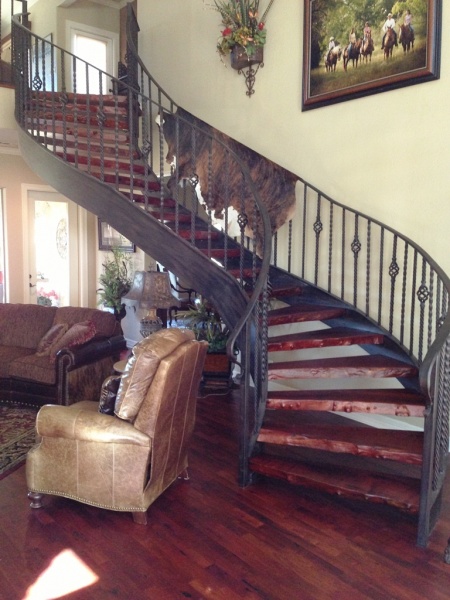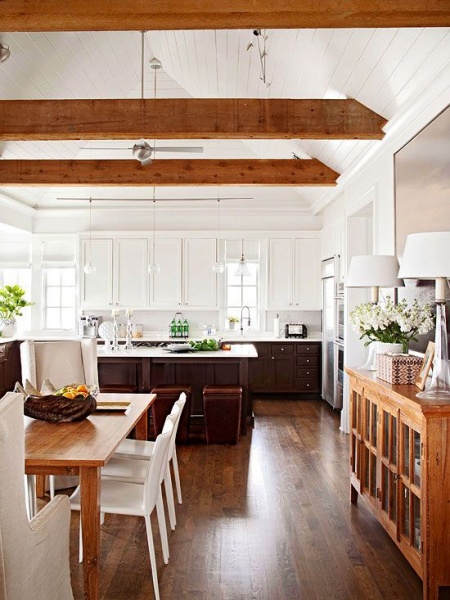The right kind of wood can bring a living space together.
Used in the right places, in the right amounts, with the right finish, mesquite wood can add a rich tone to any room in the house. But how much should be used? And for which elements, flooring, furniture, or other accents such as countertops?
Along with the wood, we must consider the colors, textures, and shapes of the other features of the house, such as textiles, glass, and other materials. It’s a lot to think about, but this is where we can really have fun creating a future home.
Where to Use Mesquite Wood
So where should you use mesquite wood in the home?
Because of the rich tone and texture of mesquite wood, it is used best in visible spaces. Countertops, mantles and tables are obvious spaces to display this kind of wood. If used in such a way, it is wise to get your mesquite wood finished properly to protect its color, texture and shape.
Next up is mesquite staircases, which can make beautiful additions to homes. As heavily foot trafficked wood, again the finish is important to maintain the woods integrity. Finally, mesquite wood flooring is another obvious way to bring together your home (for more specific information on how to install this type of flooring, read this article).

Matching Mesquite with Other Types of Wood
The key with using any wood in the home is how it is paired with other types of wood. From a purely aesthetic perspective, it is far more appealing to use more than one type of wood, as opposed to using just mesquite, or just oak.
Let’s start with tone.
Most woods have either a warm, reddish undertone, or a grey undertone. Mesquite wood has a distinctly red undertone, and therefor it is best paired with other similar colored wood.

For example, if mesquite wood is used on your kitchen or dining room, use a similar colored or finished wood on window trims, cabinets, wall moulding, and other home decor.
Adding in the Extras
The best policy when choosing decoration in the home is to mix-match hard and soft textures. Wood is naturally a hard, flat texture. Naturally, soft and rugged rugs, pillows, and throw blankets are simple contrasting elements.
Shapes are also important. Wood is typically linear and rooms are typically rectangular or square. Help to mix things up with round objects such as bowls, plants, and curved or rounded patterns.
For a fantastic example, see how this house used a mesquite wood bookshelf in combination with multiple other elements.
Final Thoughts
Mesquite wood can rightly be the main attraction in any living space, but it should not be the only attraction. In isolation, mesquite wood is not enough to complete a room. But in combination with other woods, textiles, shapes, colors and textures, along with high quality finishing, mesquite wood is a beautiful, beautiful addition.
More Inspiration:
Mesquite wood displays rich character and color not found in other hardwoods. The handsome appearance, unparalleled strength and rustic Texas style complete a grand entrance for any stairway. Faifer and Company, Inc supplies a full range of artfully-crafted mesquite wood stair parts to complete simple and elaborate staircases of all varieties.
Faifer and Company’s mesquite wood selections are reclaimed pieces from Texas ranchlands, carefully chosen for their aged charm and inimitable detail. The individual pieces combine to create a striking impression and complementary Texas motif in your foyer, living room or basement. An extensive selection of sizes with nosings, risers and reducers allows you to create any staircase and fulfill your unique elevation, height and aesthetic requirements.
Browse the stair gallery to take a closer look at completed mesquite wood staircases. See the parts listed below to start building your staircase and contact Faifer and Company Inc. for distinctive wooden stair treads and risers in Texas.
Will have clear and possibly small knots, checks and other natural defects allowed, along with the natural varying color of the wood. Sapwood is not allowed on finished surfaces. Lengths vary from 9 inches to 48 inches with tongue and groove. Ends are square cut. On average the lengths will vary between 16″ – 22″.
Will have semi clear, small to large knots, checks and other natural defects allowed, along with the natural varying color of the wood. Sapwood is not allowed on finished surfaces. Lengths vary from 9 inches to 48 inches with tongue and groove. Ends are square cut. On average the lengths will vary between 16″ – 22″.
Wood Blocks – Only one grade available. Knots, checks and other natural defects are allowed. Partly filled with black epoxy. Width is 3 inches and lengths from 2 inches to 5 inches.
The Janka (or side) hardness test measures the force required to embed a .444 – inch steel wall to half its diameter in wood. It is one of the best measurements of the ability of a wood species to withstand denting and wear. By the same token, it is also a good indicator of how hard or easy a species is to saw or nail. Northern Red Oak, for example, has a Janka hardness rating of 1290. Brazilian Cherry, with a rating of 2350, is nearly twice as hard. If you’re accustomed to working with Red Oak and decide to tackle a job with Brazilian Cherry, you can expect it to be much harder to cut and nail.
| Wood Species | Rating |
| Ipe | 3680 |
| Brazilian Teak | 3540 |
| Brazilian Cherry (jatoba) | 2820 |
| Live Oak | 2680 |
| Purpleheart | 2520 |
| Spotted Gum | 2473 |
| Mesquite | 2345 |
| Santos Mahogany | 2200 |
| Sydney Blue Gum | 2023 |
| Merbau | 1925 |
| Jarrah | 1910 |
| Hickory/Pecan | 1820 |
| Padauk | 1725 |
| Wenge | 1630 |
| Brazilian Maple | 1500 |
| Sapele | 1500 |
| Hard Maple | 1450 |
| Australian Cypress | 1375 |
| White Oak | 1360 |
| Tasmanian Oak | 1350 |
| White Ash | 1320 |
| Beech | 1300 |
| Red Oak (Northern) | 1290 |
| Birch | 1260 |
| Iroko | 1260 |
| Antique Heart Pine | 1225 |
| Thai/Burmese Teak | 1078 |
| American Black Walnut | 1010 |
| Black Cherry | 950 |
| Southern Yellow Pine (Longleaf) | 870 |
| Southern Yellow Pine (Loblolly & Shortleaf) | 690 |
| Douglas Fir | 660 |
.Source: Hardness ratings for most species taken from Wood Handbook: Wood as an Engineering Material (Agriculture Handbook 72, Forest Product Laboratory, Forest Service U.S. Department of Agriculture; revised 1987). Except for Australian Cypress, Wenge, African Padauk, Merbau and Santos Mahogany, which were provided by International Hardwood Flooring; Heart Pine by Mountain Lumber and Mesquite by Mesquite Products of Texas.
Douglas Fir rating is an average of ratings for coast, Interior West and Interior North species.
(Ranked by percentage of tangential shrinkage from green to oven-dry moisture content)
The numbers in the chart reflect the dimensional change coefficient for the various species, measured as tangential shrinkage or swelling within normal moisture content limits of 6 – 14 percent. Tangential change values will normally reflect changes in plainsawn wood. Quartersawn wood will usually be more dimensionally stable than plainsawn.
The dimensional change coefficient can be used to calculate expected shrinkage or swelling. Simply multiply the change in moisture content by the change coefficient, than multiply by the width of the board.
Example: A mesquite (change coefficient – .00129) board 5 inches wide experiences a moisture content change from 6 to 9 percent – a change of 3 percentage points.
(Calculation: 3 x .00129 = .00387 x 5 = .019 inches).
In actual practice, however, change would be diminished in a complete floor, as the boards’ proximity to each other tends to restrain movement. The chart is best used for comparison.
* Although some tropical woods such as Australian Cypress, Brazilian Cherry, Merbau and Wenge appear in this chart to have excellent moisture stability compared to domestic oak, actual installations of many of these woods have demonstrated significant movement in use. To avoid problems later, extra care should be taken to inform potential users of these tendencies prior to purchase.
| Wood Species | Rating |
| Beech | 11.9 |
| Jarrah | 11.0 |
| White Oak | 10.5 |
| Hard Maple | 9.9 |
| Yellow Birch | 9.5 |
| Hickory/Pecan | 8.9 |
| Brazilian Maple | 8.8 |
| Northern Red Oak | 8.6 |
| Brazilian Cherry (jatoba) | 8.5 |
| Bubinga | 8.4 |
| Brazilian Walnut (Ipe) | 8.0 |
| White Ash | 7.8 |
| American Black Walnut | 7.8 |
| Brazilian Teak | 7.6 |
| Southern Yellow Pine | 7.5 |
| Sapele | 7.4 |
| Douglas Fir | 7.3 |
| Black Cherry | 7.1 |
| Santos Mahogany | 6.2 |
| Purpleheart | 6.1 |
| Thai/Burmese Teak | 5.8 |
| Wenge | 5.8 |
| Padauk | 5.2 |
| Merbau | 4.6 |
| Iroko | 3.8 |
| Mesquite | 3.2 |
| Australian Cypress | 2.8 |
.Source: stability ratings taken from Wood Handbook: Wood as an Engineering Material (Agriculture Handbook 72, Forest Products Laboratory, Forest Service, U.S. Department of Agriculture; revised 1987).